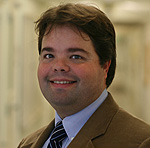December 5, 2012 - By Lisa Trei

Carlos Bustamante
In an effort to harness vast amounts of genomic data that can benefit human well-being, Stanford's School of Humanities and Sciences and School of Medicine have launched the Stanford Center for Computational, Evolutionary and Human Genomics.
The center plans to attract faculty and students from Stanford's seven schools to engage in interdisciplinary collaborations that will catalyze discovery in emerging fields of research.
After two decades of sequencing the human genome and other organisms, the field is transitioning into an "information age of genomics," said center co-director Marcus Feldman, PhD, a biology professor.
Feldman will lead the center with Carlos Bustamante, PhD, a professor of genetics in the School of Medicine.
Bustamante, who joined the faculty in 2010, said Stanford is a logical place to support the computational analysis of genomic data. "Stanford sits at an amazing nexus of medicine, science, engineering and the humanities that is incredibly exciting," he said. "If the center is successful, we will catalyze a collaborative environment for understanding how genomics can improve human well-being."
Researchers have access to vast amounts of genomic data, Feldman said, but interpreting even the simplest genomes remains a daunting challenge. Researchers also face ethical and legal problems related to the use of findings. Addressing such challenges is critical if scientists are to effectively translate genomic data
into scientific advances that can help promote health, agriculture and biotechnology, he said.
Executive committee members of the new center include Dmitri Petrov, PhD, professor of biology; Noah Rosenberg, PhD, associate professor of biology; Chiara Sabatti, PhD, associate professor of health research and policy; and Hank Greely, JD, professor of law.
The group aims to take advantage of Stanford's long-standing culture of interdisciplinary collaboration to place the university at the forefront of genomics data research worldwide.
"We need to play to our strengths in large data analysis and scholarly innovation to organize teams of interdisciplinary investigators to address large-scale problems," Feldman said.
The center, which is open to all university faculty and labs, aims to promote interaction and collaboration. Planned activities include:
- Support for graduate and postdoctoral students.
- Support for small project grants, including student-initiated research.
- Computational genomics analysis service to support member labs and faculty, students and staff.
- Public outreach. During the first year, the center will present programs on "Genomics and social systems," "Agricultural, ecological and environmental genomics" and "Medical genomics."
- Consulting with academic institutions, industry, government and nonprofit organizations to facilitate collaboration and transfer knowledge.
Center funding and research
Five years of funding for the center has been provided by Richard Saller, dean of the School of Humanities and Sciences; Lloyd Minor, dean of the School of Medicine; Ann Arvin, dean of research; Provost John Etchemendy; and President John Hennessy.
Feldman, the first winner of the Stanford Prize and Research Award in Population Genetics and Society, plans to use the award to support research in the new center, which could help identify risk factors for common diseases.
"We're not able to pick out what are the major genetic contributions to coronary heart disease," he said. "It's still the case that smoking, exercise and diet are much better predictors than genotypes [genetic traits in organisms] for something like this." If statisticians could use computational analysis to understand the interactions of hundreds of genes, he said, scientists could better identify risk factors.
Researchers at the new center will also harness "big data" to analyze how the potential effects of climate change could affect genomic variation in crops, Bustamante said. This knowledge could be used to develop crops using natural genetic variations that will make them less susceptible to atmospheric changes.
"We know about the controversy surrounding genetically modified organisms," he said. "A real alternative is to use genomic information to make very directed changes so you're using naturally occurring variations rather than introducing genes from different organisms."
For example, researchers seeking to cross a drought-tolerant crop with a related high-yielding crop can now use genetic markers to make specific changes. "It's almost like a surgical excision where you take this little bit of DNA and put it onto a different background," Bustamante said. "This idea has been around for a decade but we're only now able to use it, thanks to advances in computational analysis."
Collaborating with the humanities and social sciences
According to Feldman and Bustamante, expanding interaction with the humanities and social sciences is a motivating factor in establishing the center. "We really can't make effective interpretations unless we take the history of human behavior into account," Feldman said.
Feldman views the study of human genomics as "the genes, the bones and the languages." The bones are the fossil record, revealing information about paths of migration, where people settled and what tools they used. Studying variations in linguistics also helps explain how groups separated. If people could not communicate, he said, gene flow diminished.
Bustamante, a member of the Center for Comparative Studies in Race and Ethnicity, added that scientists benefit when they incorporate an understanding of the past into interpreting patterns of genetic variation.
Earlier this year, Bustamante was part of a team that sequenced the genome of a 5,300-year-old mummy discovered in the Italian Alps in 1991. Genetically, the mummy's closest modern relatives live on the islands of Sardinia and Corsica. "How do we understand that?" he said.
"The genes are only going to take us so far. Now we need to understand the history of colonization, archaeology, anthropology and the historical record in a way that geneticists usually don't. That, to me, is one of most rewarding aspects of this effort."
Lisa Trei is the associate director of communications for Stanford's School of Humanities and Sciences.
About Stanford Medicine
Stanford Medicine is an integrated academic health system comprising the Stanford School of Medicine and adult and pediatric health care delivery systems. Together, they harness the full potential of biomedicine through collaborative research, education and clinical care for patients. For more information, please visit med.stanford.edu.